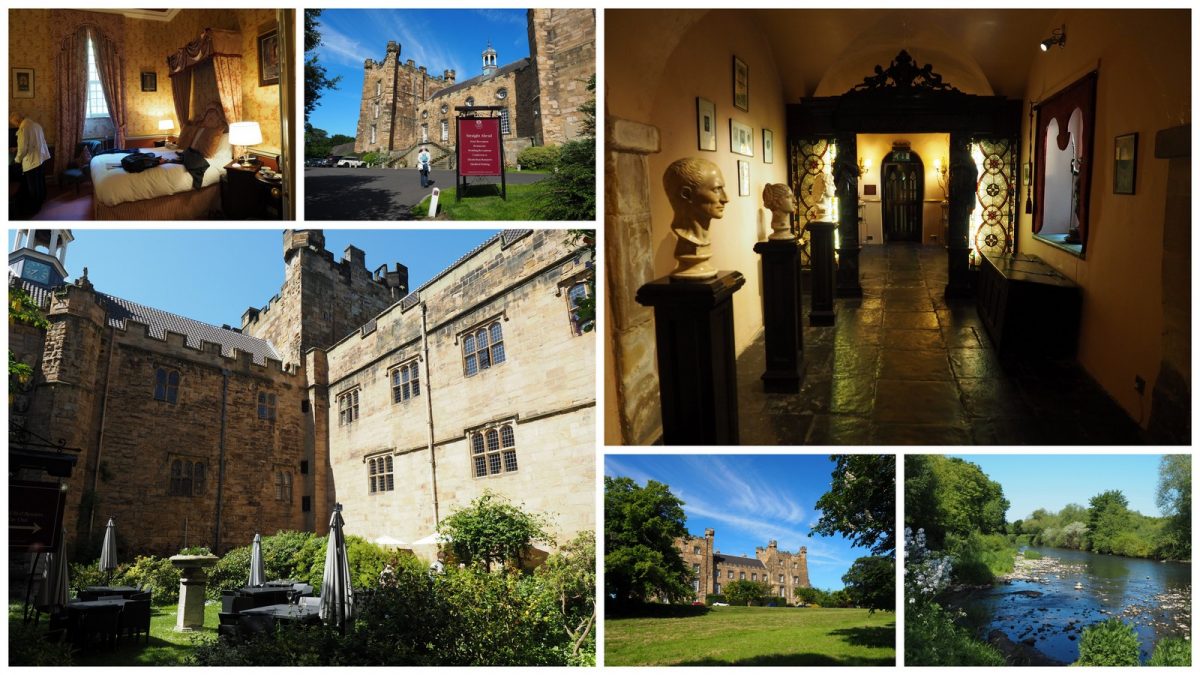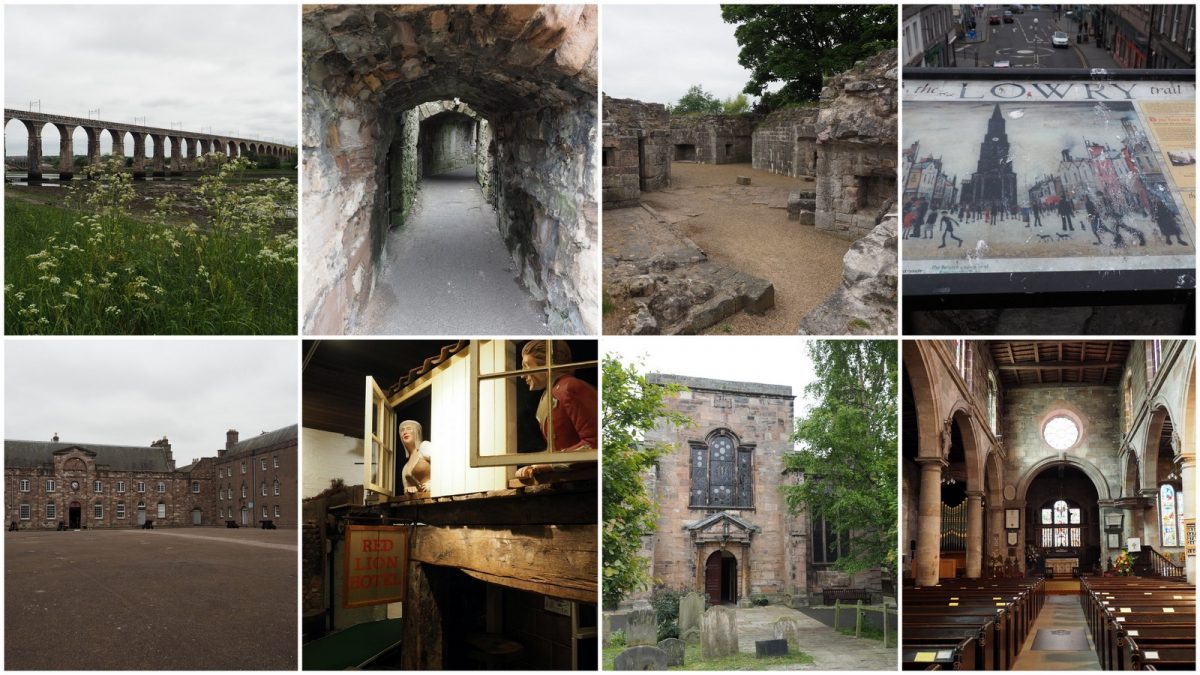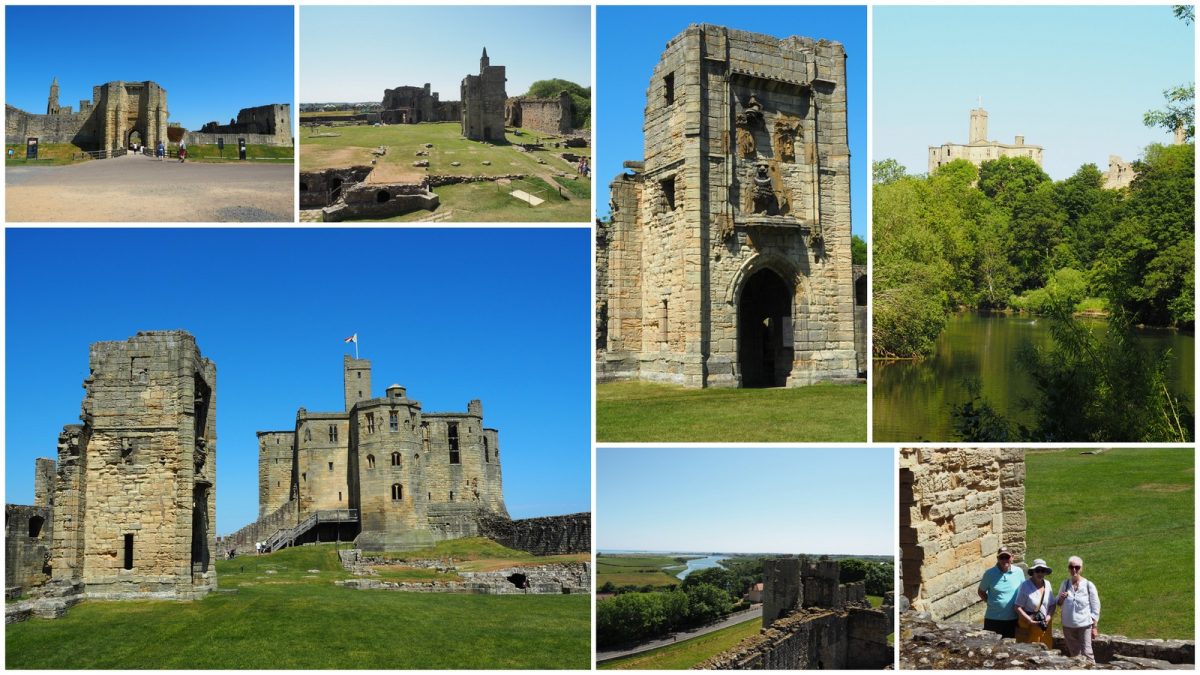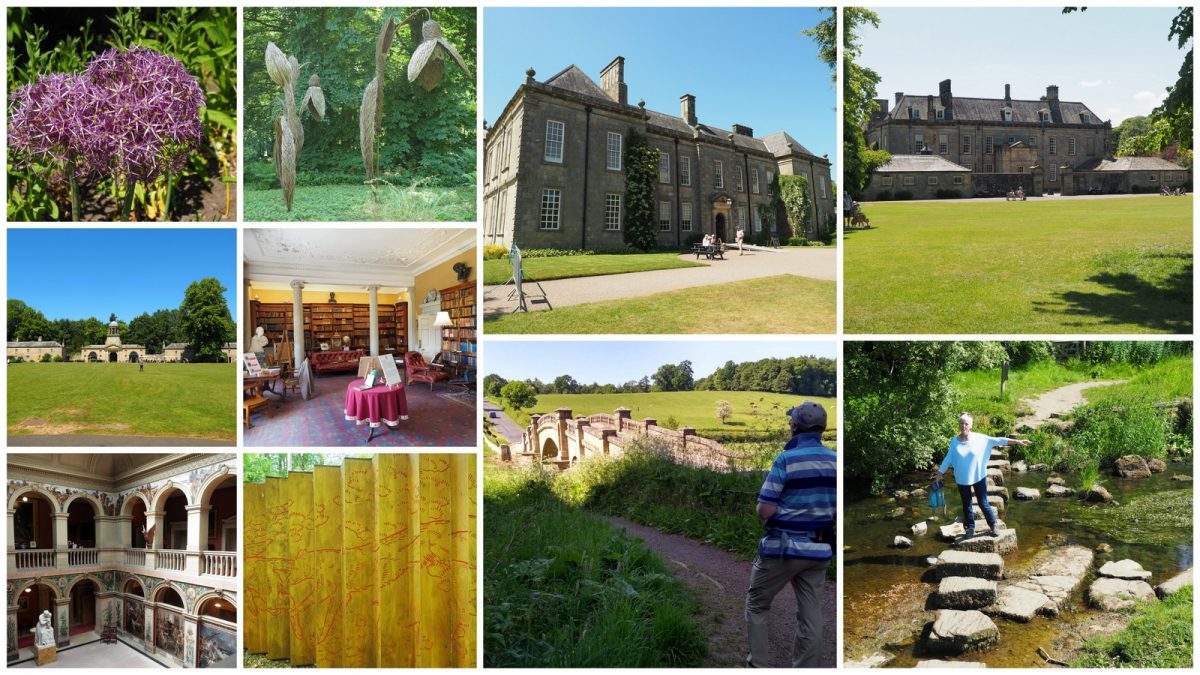With apologies to the living legend, but for some reason as we report back on the first of this year’s annual catsitting sojourns, Leo’s ‘Moonlighting‘ came to my ageing memory (and then found its way on to the page by way of the title) – so there you have it. In other news, as before, we again extended the catsitting week and explored further up the Northumberland coast, to make it feel a little more like a proper holiday.
As usual, we broke up the journey on the way up, firstly at the Wentbridge Hotel as usual, where everything was as expected, which is to say, very good. Good meal in the brasserie and a good sleep in the upgraded room – probably something to do with overnight wedding guests but we’ll let it pass. Then on to the 14th century Lumley Castle, which certainly didn’t disappoint as a castle. Hopefully the picture collage goes some way to showcasing the castle’s history and splendour. Briefly undertook a pleasant riverside walk on the edge of Chester-le-Street, also taking a quick look at the Test and County cricket Riverside ground. There was a fixture on, but we had dinner booked and so unfortunately we couldn’t go. The evening meal was lovely, the breakfast less so, but overall we enjoyed the experience.
Then on to catsitting duties whilst S&G journeyed up to Scotland on their now yearly hiking (and drinking) pilgrimage. All three cats (including the frail but still mobile Button) appeared to be in fine fettle and were little or no trouble – one minor fur ball regurgitation notwithstanding. Whist there, we were met by G’s parents who kindly took us to Tynemouth for the day, where we indulged in a pleasant walk and were guided to a lovely coffee and lunch stop. A shout out to Tynemouth rail station where its ornate Victorian ironwork canopies have earned it Grade II listed status. They were restored in 2012, and the station now provides a venue for a weekend “flea market”, book fairs, craft displays, coffee shops, restaurants, exhibitions and other events – very pleasant we imagine . S had also offered us a freebie (unused vouchers apparently) train journey up to Berwick Upon Tweed, which I confidently recalled I’d visited once before over twenty five years ago (remembered nothing but a vague recollection about the old, original town walls). Armed with the trail, we visited the viaduct, castle and castle walls, fortifications such as Cow Gate and Henry VIII’s Gun Tower before finishing off at the 18th Century Barracks and Main Guard. We didn’t finish the trail as lunch was definitely calling us big time. After we were suitably satiated, we returned to the Barracks – we were a little late, but still managed to squeeze in the The King’s Own Scottish Borderers museum, the Berwick Gymnasium Art Gallery and the Berwick Museum and Art Gallery, all of which are housed within the grounds. All more than worth a look and it was English Heritage as well, so someone got Yorkshire entry prices!! However, still came away with a couple of China Churchill mugs and an Ord Cross ‘replica’ pendant. Quick pit stop at the Church of the Holy Trinity and St. Mary, whose main body was built in Cromwellian times and is England’s most northerly parish church. It had a surprisingly captivating interior (see Berwick trail collage). Also learned that Lowry had a strong connection to Berwick, of which I was blissfully unaware. All that and the first rail journey(s) since before the pandemic!
Following a Lebanese take-out with S&G on the night of their return, we said our goodbyes and set off to Eshott Hall for five nights and the next part of our journey, which was timed to coincide with our “China friends‘, who were having a week’s break based in nearby Wooler. The hall was lovely, although perhaps not quite what we had imagined. On the first evening, we had a ‘fine dining’ evening meal, which was very pleasant, but we chose not to repeat it purely because it never varied and the choices on offer were a little limited…not a complaint, more a case of culinary preference. We then managed to fit in the following, in what I hope is some attempt at the right order :-
- Alnwick (and in particular Alnwick Castle) was first up. Mrs. No Name had been before but it was my first visit and I thoroughly enjoyed both the town and its fortifications. Our friends were there and we managed to also squeeze in a lovely two courser at an authentic Italian restaurant not too far from the castle. Very tasty and it was one of the Chinese couple’s birthday, so a fitting celebration as well. The Castle was indeed worthy of a visit, its 950 year old story a tale of military outpost, a film set and a constant home for the Percy family. The ramparts, the State Rooms and museum were all open and we enjoyed exploring. On the way back we half accidentally called in to Amble on what was the a very late afternoon. We wandered around an inlet, more to get a little exercise than to explore the village, and we were rewarded with some excellent late afternoon light. Picturesque views of Coquet Island as well, which is now an RSPB reserve and home to some 35,000 seabirds. They cram onto this tiny island to breed. Most famously, puffins whose cute and clumsy mannerisms have earned them the nickname of the ‘clowns of the sea’, visit in their thousands. Of course, this simple meander meant that we missed the harbour filled with fish shacks, seafood eateries and Amble’s small town centre with “a High Street crammed with cosy cafes, restaurants and traditional pubs perfect for tasting local tipples“. Hey ho!!
- We then too a trip up to Bamburgh intent on visiting both Bamburgh Castle and the Grace Darling Museum. On my last visit over thirty years ago I missed Grace Darling (these things fester I find) and was keen not to miss it on this occasion. First though was Bamburgh and the castle did not disappoint. A Royal fortress, Norman stronghold and a coastal home, Bamburgh Castle has stood guard above the spectacular Northumberland coastline for over 1,400 years. Spanning nine acres of land on its rocky plateau, the Castle is apparently one of the largest inhabited castles in the country. The staterooms were incredibly interesting, full of Anglo Saxon treasures through to the more typical weapons, armoury, paintings and beautiful ceramics. The small aviation museum was worth more than a little of our time, not least because of its connections to William Armstrong, who I knew not from his links to the castle but from his connection to ‘nearby’ Cragside and his role in the development of domestic electric lighting. Having said all that, the Armstrong family are still the owners of the castle! Interesting contrast to Alnwick castle, with a more relaxed vibe and more photograph friendly; it also has the advantage of a wonderful coastal position, offering super views of the Northumberland coastline.
- After a much needed refreshment stop (inside the castle) we wandered up the main street in search of the Grace Darling Museum. It was both a disappointment and a joy. It was free to enter, understandably so because it was so small (one lighthouse shaped, circular room, hence disappointing) and yet it told you everything you needed to know about her life and work. It guides you through Grace’s upbringing and life in the lighthouse, the events of the rescue that propelled her into the limelight and her status as a national heroine. You can learn about Grace’s story through her personal items, including letters, family portraits and the famous coble used in the rescue. And like so many of that time, her heroism and bravery did not preclude an early death, as she succumbed to tuberculosis (consumption) at the very young age of 26!! Following a speedy visit to the Church and interior and exterior Grace Darling memorials and driven on by the four hour parking limit, we then decided to visit the village of Seahouses. Overall, I was a little underwhelmed and was interested to hear Mrs. No Name argue that it wasn’t really the place she remembers from her childhood. I’ve mentioned it many times before but all these places have to make planning and development decisions that determine the future of their village. It seems that on this occasion they’ve gone for a more, let’s say, family friendly traditional resort. Nothing wrong with that of course, but it does make the traditions, history and soul of the place much more difficult to uncover. I think we both concur that in retrospect we would have preferred more time in Bamburgh. On the way back to the hotel, we took a minor detour to Beadnell, a quiet unspoilt village with a (very) small harbour. Beadnell is a lovely little town on the Northumberland coast, possibly lesser well known than places such as Bamburgh or Craster, but it is still a beautiful little spot. The Beadnell Lime Kilns are situated on the harbour and were built in 1798. By lighting fires with coal in the kilns and adding crushed limestone, lime was produced and used as fertilizer in the nearby fields. By 1822 they had already fallen out of use as kilns. They were used by local fishermen for curing herrings and today they house hundreds of lobster pots. the village is set at the end of a sheltered, horseshoe-shaped beach called Beadnell Bay. This sweeping crescent of beach make it a haven for water sports and you can kite surf, kayak, or wakeboard whether you’re an expert, or if you’ve never tried it before. Not much there, but a more accurate representation of the Northumberland coast we both remember.
- Next up was another meet up with our friends, this time at Warkworth Castle, an English Heritage property. Like most Heritage properties, this was largely ruined but in this case in addition to the exterior walls, ramparts etc. this one also had a reasonably well preserved cross shaped keep. No interior decoration, but the whole site is well signed and trailed and it is easy to imagine the building in all its pomp in its heyday in the 1300s and 1400s. Along with the Hermitage (see below) they form one of the most unusual pairs of medieval monuments in Britain. The castle was probably laid out in its present form in about 1200 and was the favoured residence of the powerful Percy family from the 14th to the 17th centuries. As the Earls (and later Dukes) of Northumberland, they were among the greatest landowners in northern England. You never stray far from the Percy family in Northumberland 🙂 The Hermitage, on the banks of the river Coquet and accessible only by boat, are the remains of a chapel, carved directly out of the cliff rock. We suspected it wouldn’t yet be open to the public but we took the riverwalk to the site anyway – we weren’t wrong, as according to the information board we were a week too early for the boat trip to the opposite bank where the chapel is sited.
- Next up, (after a suitably extended but predictable ‘accidental diversion’), was Wallington, gifted to the National Trust in 1941 by Sir Charles Trevelyan. Trevelyan was a fascinating character, a socialist MP and lover of the outdoors but who was also lovingly (and admittedly), contradictory – he’s worth a Wikipedia search (other encyclopaedic content is available). The house interior was fascinating and worth the saunter around, but the visit was made particularly worthy by the extensive grounds, including a lovely and not too taxing riverside walk through woodland and along the Wansbeck river. The Walled Garden was a particularly fine example, planted for nature and therefore attracting a variety of butterflies, bees and other wildlife. Free to NT members, we had initially thought the entry price a little steep, but there was so much to do you could easily spend a full day there……and it has to be said there is an awful lot to maintain.
After the lovely break at Eshott we made our leisurely journey back home, stopping off in Yorkshire at Owston Hall, a country estate with attached golf course. Lovely room and excellent evening meal followed by mediocre breakfast the next morning and then onwards to the Downtown outlet stop off and associated coffee break. Purchases suitably acquired, we set off back home after another very enjoyable catsitting plus holiday break experience! Thought it best not to mention the very lengthy and time consuming traffic jam on the A1, but you have now been named and shamed!!







